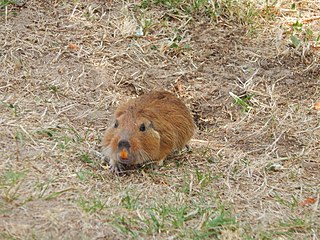
Haig's tuco-tuco, known regionally as the Patagonian tuco-tuco, is a hystricognath rodent. Like other tuco-tucos it is subterranean and thus not often observed, although the "tuc-tuc" call of the males can be heard near burrow sites, especially in the early morning. Like most species in the genus Ctenomys, C. haigi are solitary, with one adult per burrow.

The Brazilian tuco-tuco is a tuco-tuco species. It is found mainly in the state of Minas Gerais in southeastern Brazil, though Charles Darwin mentions it during his trip through present-day Uruguay.

The tiny tuco-tuco is a tuco-tuco species found in Brazil and Bolivia.

The collared tuco-tuco is a tuco-tuco species from South America. It is found in southern Brazil, Uruguay and northern Argentina, where it lives underground in a burrow it digs in savannah habitats. It is a relatively common species and the IUCN has assessed its conservation status as being of "least concern".

Colburn's tuco-tuco is a species of rodent in the family Ctenomyidae. Its only known habitat is in Argentina.
The reddish tuco-tuco is a species of rodent in the family Ctenomyidae. Five subspecies have been recognized, some formerly designated as separate species. It is found in Argentina and Bolivia at altitudes from 600 to 4,500 m. This tuco-tuco is fossorial, like others in its genus. Its diet consists of underground tubers and roots. Its karyotype has 2n = 52 and FN = 78.
The tawny tuco-tuco is a species of burrowing rodent in the family Ctenomyidae. It is found in the desert regions of northern Chile and adjoining areas of Argentina.
The white-toothed tuco-tuco is a species of rodent in the family Ctenomyidae. It is found in Bolivia and Peru.
The Mendoza tuco-tuco is a species of rodent in the family Ctenomyidae.

Pearson's tuco-tuco is a species of rodent in the family Ctenomyidae. It is endemic to Uruguay, where it is found at elevations below 200 m. This tuco-tuco constructs burrows with multiple openings containing one to two nests of dried grass; it prefers areas of sandy soil but is somewhat adaptable. It is threatened by loss of habitat to development, agriculture and ranching. Multiple karyotypes have been reported, including 2n = 68–70, FN = 80–88, as well as 2n = 56, FN = 77–79, suggesting the taxon may represent several species. C. dorbignyi appears to be cytogenetically indistinguishable from the 2n = 70 form. The species is named after American zoologist Oliver Payne Pearson.
The Goya tuco-tuco is a species of rodent in the family Ctenomyidae. It is endemic to Argentina.
The social tuco-tuco is a species of rodent in the family Ctenomyidae. It is endemic to Argentina. Its natural habitat is subtropical or tropical dry lowland grassland.

The robust tuco-tuco is a species of rodent in the family Ctenomyidae. It is a burrowing rodent and is endemic to the Tucumán Province of Argentina.

The Tucuman tuco-tuco is a species of rodent in the family Ctenomyidae. It is endemic to Argentina.
The Rio Negro tuco-tuco is a species of rodent in the family Ctenomyidae. It is found in a small fragmented range in Entre Ríos Province in northeastern Argentina and in the Río Negro Department of western Uruguay. It is restricted to sand dunes, and is threatened by the conversion of this habitat to forestry plantations.
Budin's tuco-tuco was formerly considered a species of rodent in the family Ctenomyidae. It is endemic to southeast Jujuy Province in northwest Argentina. Given the extensive human presence in its limited range, it has been suspected to be threatened. The IUCN currently views it as a subspecies of C. frater. It was named after Emilio Budin, an Argentine specimen collector who worked with Oldfield Thomas.

D'Orbigny's tuco-tuco is a species of rodent in the family Ctenomyidae, named after French naturalist Alcide d'Orbigny. It is found in northeast Argentina. Its karyotype has 2n = 70, FN = 84–88, which is cytogenetically indistinguishable from some populations of C. pearsoni; the latter taxon may actually represent several species.

Flamarion's tuco-tuco or the tuco-tuco of the dunes is a rodent species of the family Ctenomyidae Its karyotype has 2n = 48 and FN = 50–78. It is endemic to the coastal dunes of Rio Grande do Sul state, southern Brazil. The species is threatened by habitat loss due to dune removal and urbanization. It is named after Brazilian biologist Luiz Flamarion B. de Oliveira.

The Lami tuco-tuco is a species of rodent in the family Ctenomyidae. It is endemic to an area in the state of Rio Grande do Sul in southern Brazil, where it is found in the vicinity of sand dunes. The species is threatened by urbanization and the conversion of its habitat to agricultural use. Swamp drainage has led to a zone of hybridization with a neighboring population of C. minutus.











